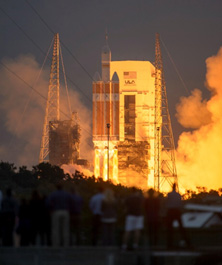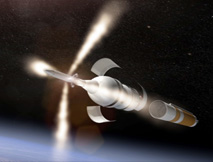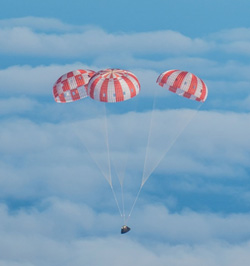Exploratory Test Flight 1 of the Orion Spacecraft, Friday December 5, 2014
by Laurie Averill

Launch

Artist’s Rendition of Jettison of Launch Abort System

Three Main Parachutes Slowing Descent of Crew Module. Images courtesy of NASA.
On Friday, December 5, 2014, at 7:05 AM Eastern Standard Time, the first Exploratory Test Flight of the Orion spacecraft lifted off from Flight Pad at Cape Canaveral, Florida. After the launch was scrubbed on Thursday, due to the failure of valves to close, there was concern that the launch would not occur during the next day, but it did and was virtually flawless.
ASNH member Andy Poniros witnessed the launch in person as a member of the press and made an audio recording of the powerful Delta IV – Heavy rocket. Reflecting on his experience, Andy said that he was with several hundred members of the press corps. After he had set up his recording equipment and made a final check, he took the last few moments before the launch to pause and appreciate the moment. He looked at the people around him, one was praying, another was nervously chewing on his hand, a third was making a last check of his camera equipment. All had gathered to witness the first flight of the Orion spacecraft, all had a passion about travel into deep space, all focused on the success of the mission.
The purpose of the Exploratory Test Flight 1 was to test under real flight conditions Orion spacecraft systems critical to the safe launching, ascent, and reentry of the crew. Because this first test mission was uncrewed, modified crew and service modules were used, only the jettison motor of the three motors of the Launch Abort System was operational, and Delta IV- Heavy rocket was used instead of the people-grade Space Launch System that is currently being built at the Marshall Space Center in Huntsville, Alabama, and will be used during the next uncrewed mission scheduled for 2017.
During its four hour mission, the Orion Spacecraft travelled 60,000 miles completing two Earth orbits, one near-Earth and the other high-altitude reaching a distance of 3,600 miles from Earth’s surface. It successfully underwent tests of critical systems.
The jettison motor of the Launch Abort System was tested. It successfully separated the abort tower, primary production structure, and the boost protective cover and acoustic shield. The motor jettisoned the LAS away from the crew module with 30,000 pounds of thrust during early ascent stage of the flight.
Another key test of the mission was the jettisoning of fairing panels that enclose the service module to protect it from heat, wind, and sound as it climbs into space. They also support half of the weight of the crew module and Launch Abort System during launch and ascent. After ascent, the fairings were jettisoned at about 560,000 feet. To separate in specific sequences, six breakable joints were broken, six explosive separation bolts were fired, and six spring assemblies successfully pushed the panels away.
On this test mission the service module provided structural support to the crew module and did not contain the payload and systems that it would during a crewed mission. The test of the separation from the crew module was successful.
The crew module re-entered Earth’s atmosphere at a speed of about 20,000 mph with its heat shield withstanding a temperature exceeding 4,000 degree F. The heat shield was the largest of its kind made of a titanium web covered with a honeycomb of 300,000 individual cells that are filled by hand with Avocat, an oblative material that protects the crew module from the extreme heat of re-entry by partially burning off.
The Forward Bay Cover was jettisoned when a series of pyrobolts were activated, thrusters ignited, and the cover was pulled away from the crew module by the first set of the parachutes at 23,000 feet. Next to deploy were the drogue parachutes that slowed the spacecraft down to 307 mph. Then pilot parachutes opened to help deploy the three main parachutes that opened in stages and slowed the descent of the crew capsule to 17 mph, a safe splashdown speed. The crew capsule hit the water within about a mile of the expected location in the Pacific Ocean off the coast of the Baja Peninsula. The eleven parachutes deployed in a perfectly choreographed sequence to slow re-entry speed from 324 to 17 mph. The successful test of the re-entry system shows that it dependably operates as the crew module re-enters Earth’s atmosphere.
The capsule was successfully recovered by the Navy using a specially designed ship with a well deck that allowed the capsule to be floated right onto the flooded, sea-level deck.
